Storm Readiness and Response

What to report
Emergency Issues
- Downed trees, large branches or powerlines
- Blocked roadside storm drains or flooding
- Blocked access to roads, sidewalks, parks, or public pathways
- Traffic signal light out (completely off — not flashing to red)
Monday - Friday - 7:00 am – 4:00 pm call Public Works: 415-485-3355
After hours, call SRPD Dispatch (24/7): 415-485-3000
*To report a downed powerline, call PG&E at 1-800-743-5002
Non-emergency issues
- Blocked or partially blocked storms drains not causing flooding
- Leaves or small branches
- Minor damage to property or road signs
- Traffic signal light flashing to red
Contact Public Works: please use SeeClickFix portal anytime or call (415) 485-3355 during Public Works' business hours.
Helpful Webpages
- Federal Emergency Management Agency (FEMA) Preparedness Information
- National Weather Service - San Francisco Bay Office
- National Oceanic And Atmospheric Administration (NOAA) Flood Hazard Information
- Marin County Flood Control District
- Marin County Telephone Emergency Notification System (TENS)
- Nixle Emergency Notifications from the Police Department



